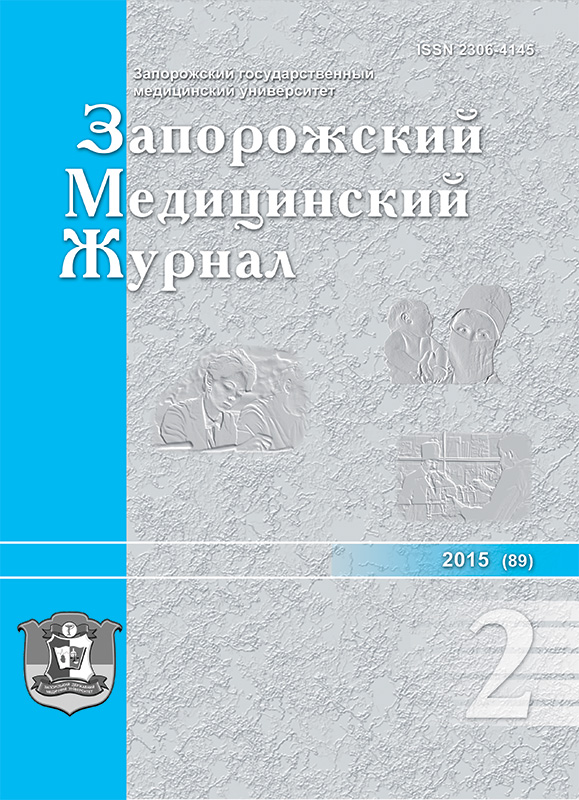Morphogenesis of the liver fibrosis development and progression in chronic hepatitis C
DOI:
https://doi.org/10.14739/2310-1210.2015.2.42063Keywords:
Hepatitis C Chronic, Liver Stellate Cells, FibroblastsAbstract
Aim. The paper contains the results of pathohistological integrated computer-morphometric and immunohistochemical liver bioptates research of the patients with chronic viral hepatitis C to upgrade the most significant microscopic features of the liver fibrosis development and progression.
Methods and results. As a result of the research, histological activity index of chronic viral hepatitis C didn’t correlate in all the patients with liver fibrosis, found in histological preparations colored by Masson’s trichrome Stain or van Gieson’s Stain.
Conclusion. It has been stated that the prognostic signs of probability of liver fibrosis development in patients with chronic viral hepatitis C are hyperplasia of the activated positive A-SMA Ito cells in the liver perisinusoidal spaces and segmental collagenization of the intralobular venous sinusoids walls, availability of A-SMA positive fibroblasts in immunocellular «piecemeal necrosis» and in portal paths.
References
Storozhakov, G. I., & Ivkova, A. N. (2009). Patogeneticheskie aspekty fibrogeneza pri khronicheskikh zabolevaniyakh pecheni. [Pathogenetic aspects of fibrogenesis in chronic liver diseases]. Klinicheskie perspektivy gastroe`nterologii, gepatologii, 2, 3–10. [in Russian].
Ivanis, V. A., Putilova, E. A., Gorelova, I. S., Sklyar, L. F., & Markelova E. V. (2012). Znachenie MMP-9 v diagnostike fibroza pecheni u bol`nykh khronicheskimi mono- i mikst-virusnymi gepatitami [Role of matrix metalloproteinase-9 in diagnosing liver fibrosis in patients with chronic monoand mixed viral hepatitis]. Tikhookeanskij medicinskij zhurnal, 4, 74–77. [in Russian].
Sklyar, L. F., Markelova, E. V., & Gorelova I. S. (2014). Citokinovyj profil` i fibrozreguliruyuschaya aktivnost` ronkolejkina pri khronicheskom virusnom gepatite C. [Cytokine profile and fibrosis-regulating activity of Ronkoleukin in chronic viral hepatitis C]. Citokiny i vospalenie, 13(1), 44–50. [in Russian].
Beloborodova, E. V., Beloborodova, E`. I., Akbasheva, O. E., Serebrov, V. Yu., Chernogorjuk, G. E., Rachkovskij, M. I., et al. (2010). Aktivnost` elastazo-, kollagenazopodobnykh proteinaz i ikh ingibitorov v plazme krovi pri metabolizme kollagena v usloviyakh khronicheskogo techeniya zabolevanij pecheni virusnoj i toksicheskoj etiologii [Activity elastazo- , kollagenazopodobnyh proteinases and their inhibitors in blood plasma in collagen metabolism in chronic liver disease course and toxic viral aetiology]. Byulleten` Sibirskogo otdeleniya Rossiyskoj akademii medicinskikh nauk, 2, 94. [in Russian].
Beloborodova, E`. I., Serebrov, V. Yu., Akbasheva, O. E., Chernogoryuk, G. E., Rachkovskiy, M. I., Beloborodova, E. V., et al. (2009). Mekhanizmy progressirovaniya fibroza v pecheni pri khronicheskom techenii zabolevanij virusnoj i toksicheskoj etiologii. [Mechanisms of progression of liver fibrosis in chronic viral diseases during and toxic etiology]. Medicinskij vestnik Severnogo Kavkaza, 14(2), 19. [in Russian].
Friedman, S. L., Rockey, D. C., & Bissell, D. M. (2007). Hepatic fibrosis 2006: report of the third AASLD Single Topic Conference. Hepatology, 45, 242–249.
Parsons, C. J., Takashima, M., & Rippe, R. A. (2007). Molecular mechanisms of hepatic fibrogenesis. J. Gastroenterol. Hepatol., 22(1), 79–84. doi: 10.1111/j.1440-1746.2006.04659.x.
Downloads
How to Cite
Issue
Section
License
Authors who publish with this journal agree to the following terms:
- Authors retain copyright and grant the journal right of first publication with the work simultaneously licensed under a Creative Commons Attribution License that allows others to share the work with an acknowledgement of the work's authorship and initial publication in this journal.

- Authors are able to enter into separate, additional contractual arrangements for the non-exclusive distribution of the journal's published version of the work (e.g., post it to an institutional repository or publish it in a book), with an acknowledgement of its initial publication in this journal.
- Authors are permitted and encouraged to post their work online (e.g., in institutional repositories or on their website) prior to and during the submission process, as it can lead to productive exchanges, as well as earlier and greater citation of published work (See The Effect of Open Access)

